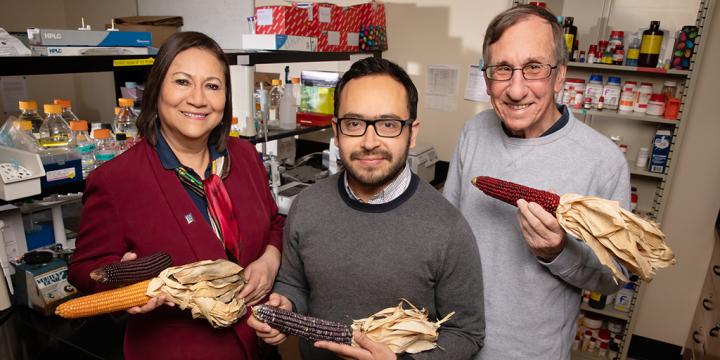
IMAGE: Scientists at the University of Illinois developed new hybrids of purple corn and found that compounds in them fight obesity, inflammation and insulin resistance in mouse cells. The team includes,… view more
Credit: Photo by L. Brian Stauffer
CHAMPAIGN, Ill. — Scientists at the University of Illinois have developed new hybrids of purple corn containing different combinations of phytochemicals that may fight obesity, inflammation and diabetes, a new study in mice indicates.
The pericarp – or outer layer – of purple and other brightly colored corn kernels also may provide an alternative source of colorants for food products, giving corn producers another value-added product from their crop, said the U. of I. team led by food science professor Elvira Gonzalez de Mejia and crop sciences professor John Juvik. They published their findings recently in the journal Food Chemistry.
From a strain of maize called Apache Red, Juvik’s team bred 20 genetic varieties of purple corn, each with a unique combination of anthocyanins, the nutritious, natural pigments that give the pericarp its vibrant color.
Widely found in plant tissues, phenolic compounds tend to be aromatic and contribute to the color, flavor and acidity of fruits. Anthocyanins are one class of phenols, and studies have associated the consumption of anthocyanin-rich foods with reduced risks of cardiovascular disease, Type 2 diabetes and certain types of cancer.
Using pressurized water, postdoctoral researcher and study co-author Diego Luna-Vital extracted the anthocyanins from the pericarp of the corn kernels, creating anthocyanin-rich water extracts that were then freeze-dried. While analyses of the extracts showed that the pericarp is an abundant source of anthocyanins and phenolic compounds, the concentration varied significantly among the varieties.
To examine the impact of anthocyanins on obesity-induced inflammation, then-graduate student and first author of the study Qiaozhi Zhang combined fat cells – called adipocytes – from mice with large immune cells called macrophages.
The mouse cell models in the study simulated those of obese people with high concentrations of lipids and inflammation in their cells, or healthy individuals who regularly eat plants containing phenolic compounds, de Mejia said. “So these are very real models that can be translated into in vivo studies with humans or animals.”
“We evaluated some very specific biomarkers already known to be related to inflammation and adipogenesis, which is the conversion of pre-adipocytes to mature adipocytes that accumulate fat,” Luna-Vital said.
They observed that the phenolic compounds in the extracts altered the cells’ development, reducing the adipocytes’ fat content from 8%-56%, depending on the differing phenols used.
To study the compounds’ impact on insulin resistance, the metabolic dysfunction associated with diabetes, the scientists used a cell-signaling protein to induce insulin resistance in the mouse fat cells, then treated the cells with the anthocyanin compounds and monitored their glucose uptake.
A key marker of insulin resistance decreased by 29%-64%, they found, and the cells’ glucose uptake decreased by 30%-139%, depending on the chemical composition of the anthocyanins used.
“We observed very important changes in molecules that reduced oxidative stress and inflammation in the insulin-resistant adipocytes,” Luna-Vital said. “We also found important changes in pro-inflammatory molecules in the immune cells.”
The findings suggested that different levels and chemical compositions of these phenolic compounds might prevent obesity or improve the insulin profile of people who are obese, Luna-Vital said.
The smaller phenols such as quercetin, luteolin and rutin – which are present in many plant foods – played key roles in reducing some of the obesity, inflammation and some markers of Type 2 diabetes, de Mejia said. “While others, such as vanillic and protocatechuic acid, decreased the potential conversion of pre-adipocytes to adipocytes.”
She cautioned, though, that “it’s very important to note that it’s not just one or two compounds, but the combinations of phenolics” working together that were responsible for the beneficial effects.
Graduate student and study co-author Laura Chatham currently is performing genomic selection to identify the DNA markers associated with the most promising health effects in order to breed corn hybrids with those properties, Juvik said.
In addition to its health-promoting properties, the pericarp of red, purple and other brightly hued corn could serve as natural pigments for the food industry, satisfying strong consumer demand for alternatives to synthetic dyes, Juvik said.
“We calculated that all of the red dye No. 40 – one of the major dyes used in the U.S. – could be replaced with the pigment derived from about 600,000 acres of corn,” Juvik said. “And we could produce the anthocyanin-rich pericarp in sufficient quantities for manufacturers to add it to beverages or special products with pharmaceutical properties.”
Another advantage to dried corn is that it’s shelf-stable, providing an economical substitute for the perishable fruits and vegetables that manufacturers also currently use to color many foods and beverages, he said.
“The advantage to using water to extract the anthocyanins from the pericarp is that it’s the most simple, straightforward and inexpensive way for industry to remove these compounds, compared with other extraction protocols that are complicated and more expensive,” Juvik said.
###
Water extraction is also a “green” process, compliant with environmental and food and drug regulations, said de Mejia, also the director of the Division of Nutritional Sciences.
U. of I. agricultural and biological engineering professors Vijay Singh and Deepak Kumar, and undergraduate student Subhiksha Chandrasekaran co-wrote the study, along with Tianyi Tao of Zhejiang University, China.
The research was supported by a U.S. Department of Agriculture National Institute of Food and Agriculture grant.

